Learn About Edouard Manet in Art History. View His Art and Famous Paintings
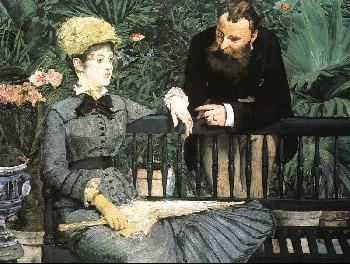
"In the Conservatory”, Edouard Manet, 1879
Edouard Manet, 1832-1883, one of France’s famous artists in art history, painted one of his most famous paintings, "Luncheon on the Grass", in 1863. The painting was rejected by the Academy Salon, Paris, and then submitted to the Salon des Refuses that same year.

A partial reason his art was rejected at the Salon, was a suspicion by the judges that he was promoting himself just before the up-coming 1863 Salon. Two months prior to the Salon opening, Edouard Manet exhibited fourteen of his paintings in a local gallery, eager to capitalize on an honorable mention award won in the Salon two years earlier submitting the painting "Spanish Guitar Player", 1860
"Luncheon on the Grass", lacking in moralistic values, and allegorical history, not to mention the audacity of the nude woman sitting undisturbed in front of two fully clothed well-dressed men must have been quite shocking to the jurors at the Salon. Edouard Manet's painting certainly was shocking to the public. The reaction to the painting is difficult to understand in light of the fact that famous artists such as Giorgione and Titian have done similar things in Giorgione's painting "Tempest", 1505-1510, and in Titian's art"Bacchanal of the Adrians", 1520. A reasonable first thought is the painting did not follow artistic academic standards of the time.
Edouard Manet painted the nude woman in a flat tone with very little transition from light to dark to capture the immediacy of the moment, much as one would see a landscape in the blink of the eye. The landscape composition has a spatial ambiguity, receding in depth behind the seated foreground figures to the woman bathing. Space has not been delineated between the foreground figures and the woman bathing, therefore the woman seems to hover in space.
Manet’s problem was he had made outdoor art studies of Nature for the landscape painting but painted the figures in his studio without any reference to natural light. This is why they look like paper cutouts pasted into the landscape.
Manet’s art is not interested in the subject matter but in an artistic way of creating a picture. Manet is looking for the best way to create a visual experience in paint medium.
Edouard Manet painted "Olympia", in 1863.
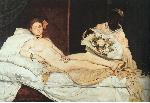 The painting is similar to "Luncheon On the Grass”, in that Manet makes no social comment and does not dramatize". There are no spatial three-dimensional ambiguities either. Again the main figure is unconcerned with her nakedness and seems detached from the viewer and her servant as well. The art is not allegorical or moral, and has no reference to academic tradition. Manet seems to be saying he is not concerned with subject matter or moralistic truisms. He is only interested in the way the picture is painted.
The painting is similar to "Luncheon On the Grass”, in that Manet makes no social comment and does not dramatize". There are no spatial three-dimensional ambiguities either. Again the main figure is unconcerned with her nakedness and seems detached from the viewer and her servant as well. The art is not allegorical or moral, and has no reference to academic tradition. Manet seems to be saying he is not concerned with subject matter or moralistic truisms. He is only interested in the way the picture is painted.
If the subject matter in Manet's two famous paintings mentioned here is not important to him, then line, form, colors, and the paint itself is important. Looking backward, today from a Twenty-first century viewpoint, to Manet's concept, we see the seeds of twentieth century, abstract art. The coined term is "Art for Art's Sake".
In 1868 Edouard Manet painted "Emile Zola", influenced by Japanese prints.
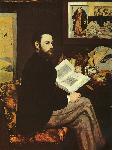 Manet painted a Japanese print in this painting on the back wall behind Zola's desk. Japanese artists were interested in the same compositional themes as Impressionist artists. They painted contemporary subject matter taken from everyday life "Emil Zola" has the same formal structure elements of the Japanese prints, a close in view, and the rectangular divisions of the background wall. Everything is neatly compartmentalized and balanced. There are no spatial ambiguities.
Manet painted a Japanese print in this painting on the back wall behind Zola's desk. Japanese artists were interested in the same compositional themes as Impressionist artists. They painted contemporary subject matter taken from everyday life "Emil Zola" has the same formal structure elements of the Japanese prints, a close in view, and the rectangular divisions of the background wall. Everything is neatly compartmentalized and balanced. There are no spatial ambiguities.
Impressionism in art history was developed during Edouard Manet's lifetime and toward the end of his painting career, he softened in his acceptance of it. In the painting "Boating", 1874, his color becomes brighter and his brush strokes more energetic.
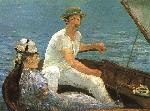 Manet captures the instantaneity of the moment showing two boaters sailing on a bright sunny afternoon, a typical art composition from out-door Impressionist painters.
Manet captures the instantaneity of the moment showing two boaters sailing on a bright sunny afternoon, a typical art composition from out-door Impressionist painters.
Another example of Manet's changing art style is his portrait of "George Moore", painted in 1879, catching the personality of the sitter much as Frans Hals did in his portrait "Malle Babbe", 1650.
One of Edouard Manet's last famous paintings in art history is the "The Bar at the Folies Bergeres" 1881, continuing his interest in the Impressionistic style.
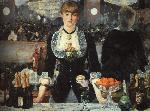 Manet’s triangular, central composition consisting of the barmaid and the lower secondary still life's extending to the left and right lower corners of the painting is, reminiscent of the formal compositions High Renaissance Art. The composition is symmetrically balanced by the strong pillar verticals in the upper background, with the horizontal balcony, the horizontal bar, and the reflection of the barmaid in the mirror. Other famous artists of the Impressionist period are Alfred Sisley and Camille Pissarro.
Manet’s triangular, central composition consisting of the barmaid and the lower secondary still life's extending to the left and right lower corners of the painting is, reminiscent of the formal compositions High Renaissance Art. The composition is symmetrically balanced by the strong pillar verticals in the upper background, with the horizontal balcony, the horizontal bar, and the reflection of the barmaid in the mirror. Other famous artists of the Impressionist period are Alfred Sisley and Camille Pissarro.
To view the gallery #1 of Edouard Manet paintings click here.
To view gallery #2,of Manet posters, click here.
Click on the graphics below to increase graphic sizes. At the same you time can also view an opportunity to purchase a poster or painting reproduction.
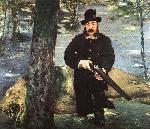
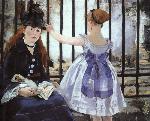
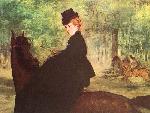

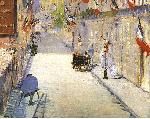
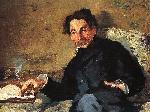
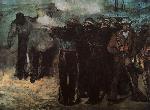
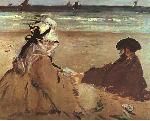
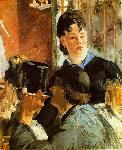
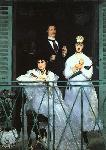
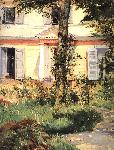
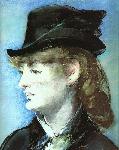















 The painting is similar to "Luncheon On the Grass”, in that Manet makes no social comment and does not dramatize". There are no spatial three-dimensional ambiguities either. Again the main figure is unconcerned with her nakedness and seems detached from the viewer and her servant as well. The art is not allegorical or moral, and has no reference to academic tradition. Manet seems to be saying he is not concerned with subject matter or moralistic truisms. He is only interested in the way the picture is painted.
The painting is similar to "Luncheon On the Grass”, in that Manet makes no social comment and does not dramatize". There are no spatial three-dimensional ambiguities either. Again the main figure is unconcerned with her nakedness and seems detached from the viewer and her servant as well. The art is not allegorical or moral, and has no reference to academic tradition. Manet seems to be saying he is not concerned with subject matter or moralistic truisms. He is only interested in the way the picture is painted.
 Manet painted a Japanese print in this painting on the back wall behind Zola's desk. Japanese artists were interested in the same compositional themes as Impressionist artists. They painted contemporary subject matter taken from everyday life "Emil Zola" has the same formal structure elements of the Japanese prints, a close in view, and the rectangular divisions of the background wall. Everything is neatly compartmentalized and balanced. There are no spatial ambiguities.
Manet painted a Japanese print in this painting on the back wall behind Zola's desk. Japanese artists were interested in the same compositional themes as Impressionist artists. They painted contemporary subject matter taken from everyday life "Emil Zola" has the same formal structure elements of the Japanese prints, a close in view, and the rectangular divisions of the background wall. Everything is neatly compartmentalized and balanced. There are no spatial ambiguities. Manet captures the instantaneity of the moment showing two boaters sailing on a bright sunny afternoon, a typical art composition from out-door Impressionist painters.
Manet captures the instantaneity of the moment showing two boaters sailing on a bright sunny afternoon, a typical art composition from out-door Impressionist painters. Manet’s triangular, central composition consisting of the barmaid and the lower secondary still life's extending to the left and right lower corners of the painting is, reminiscent of the formal compositions High Renaissance Art. The composition is symmetrically balanced by the strong pillar verticals in the upper background, with the horizontal balcony, the horizontal bar, and the reflection of the barmaid in the mirror. Other famous artists of the Impressionist period are Alfred Sisley and Camille Pissarro.
Manet’s triangular, central composition consisting of the barmaid and the lower secondary still life's extending to the left and right lower corners of the painting is, reminiscent of the formal compositions High Renaissance Art. The composition is symmetrically balanced by the strong pillar verticals in the upper background, with the horizontal balcony, the horizontal bar, and the reflection of the barmaid in the mirror. Other famous artists of the Impressionist period are Alfred Sisley and Camille Pissarro.










